YAMAHA TTR50 2015 Service Manual
Manufacturer: YAMAHA, Model Year: 2015, Model line: TTR50, Model: YAMAHA TTR50 2015Pages: 86, PDF Size: 1.87 MB
Page 41 of 86
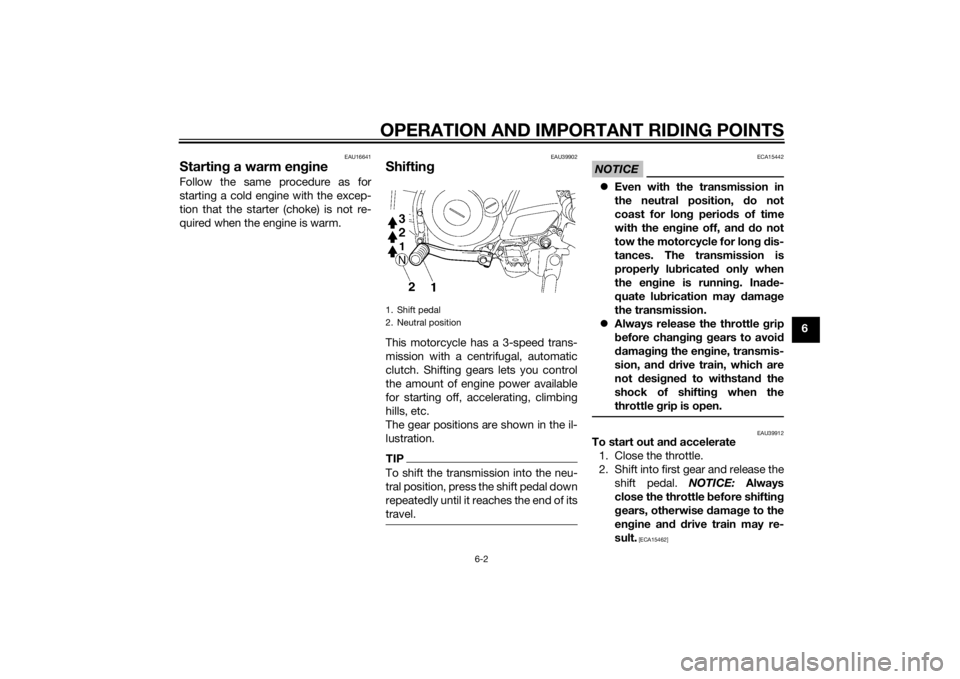
OPERATION AND IMPORTANT RIDING POINTS
6-2
6
EAU16641
Starting a warm en gineFollow the same procedure as for
starting a cold engine with the excep-
tion that the starter (choke) is not re-
quired when the engine is warm.
EAU39902
Shiftin gThis motorcycle has a 3-speed trans-
mission with a centrifugal, automatic
clutch. Shifting gears lets you control
the amount of engine power available
for starting off, accelerating, climbing
hills, etc.
The gear positions are shown in the il-
lustration.TIPTo shift the transmission into the neu-
tral position, press the shift pedal down
repeatedly until it reaches the end of its
travel.
NOTICE
ECA15442
Even with the transmission in
the neutral position, d o not
coast for lon g period s of time
with the en gine off, an d d o not
tow the motorcycle for lon g d is-
tances. The transmission is
properly lu bricated only when
the en gine is runnin g. Ina de-
quate lu brication may d amage
the transmission.
Always release the throttle grip
b efore chan gin g g ears to avoi d
d ama gin g the en gine, transmis-
sion, an d d rive train, which are
not desi gne d to withstan d the
shock of shiftin g when the
throttle grip is open.
EAU39912
To start out an d accelerate
1. Close the throttle.
2. Shift into first gear and release the shift pedal. NOTICE: Always
close the throttle before shiftin g
g ears, otherwise damag e to the
en gine an d d rive train may re-
sult.
[ECA15462]
1. Shift pedal
2. Neutral position
U2CJ82E0.book Page 2 Monday, June 23, 2014 2:58 PM
Page 42 of 86

OPERATION AND IMPORTANT RIDING POINTS
6-3
63. Open the throttle gradually.
4. Once the motorcycle has reached
a speed high enough to change
gears, close the throttle.
5. Shift into second gear and release the shift pedal.
6. Open the throttle gradually.
7. Follow the same procedure when shifting to the next higher gear.
EAU16711
To decelerate
1. Close the throttle and apply both the front and the rear brakes to
slow the motorcycle.
2. Downshift through the gears and shift the transmission into the neu-
tral position when the motorcycle
is almost completely stopped.
EAU39921
Engine break-inThere is never a more important period
in the life of your engine than the first 5
hours of riding. It is also important to
accustom the rider to the motorcycle
during this time. Please read the fol-
lowing information carefully.
Since the engine is brand new, do not
put an excessive load on it for the first
5 hours of operation. The various parts
in the engine wear and polish them-
selves to the correct operating clear-
ances. During this period, prolonged
full-throttle operation or any condition
that might result in engine overheating
must be avoided. However, momen-
tary full-throttle operation under load
(i.e., two to three seconds maximum)
does not harm the engine. Each full-
throttle acceleration should be fol-
lowed with a substantial rest period for
the engine. To allow the engine to cool
down from the temporary buildup of
heat, cruise at a lower engine speed.
After the first 5 hours of operation,
thoroughly check the motorcycle for
loose parts, oil leakage and any other
problems. Be sure to inspect and make adjustments thoroughly, especially ca-
ble and drive chain slack and loose
spokes. In addition, check all fittings
and fasteners for looseness, and tight-
en if necessary.
NOTICE
ECA10271
If any en
gine trou ble shoul d occur
d urin g the en gine break-in perio d,
imme diately have a Yamaha dealer
check the vehicle.
U2CJ82E0.book Page 3 Monday, June 23, 2014 2:58 PM
Page 43 of 86
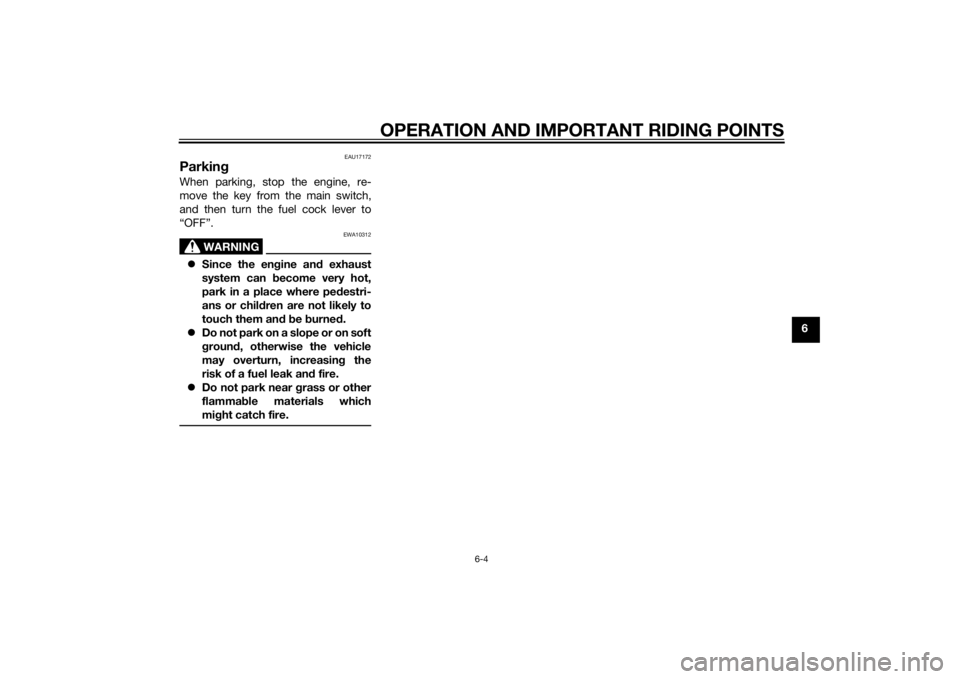
OPERATION AND IMPORTANT RIDING POINTS
6-4
6
EAU17172
ParkingWhen parking, stop the engine, re-
move the key from the main switch,
and then turn the fuel cock lever to
“OFF”.
WARNING
EWA10312
Since the en gine an d exhaust
system can b ecome very hot,
park in a place where pe destri-
ans or chil dren are not likely to
touch them an d b e burne d.
Do not park on a slope or on soft
groun d, otherwise the vehicle
may overturn, increasin g the
risk of a fuel leak an d fire.
Do not park near grass or other
flamma ble materials which
mi ght catch fire.
U2CJ82E0.book Page 4 Monday, June 23, 2014 2:58 PM
Page 44 of 86
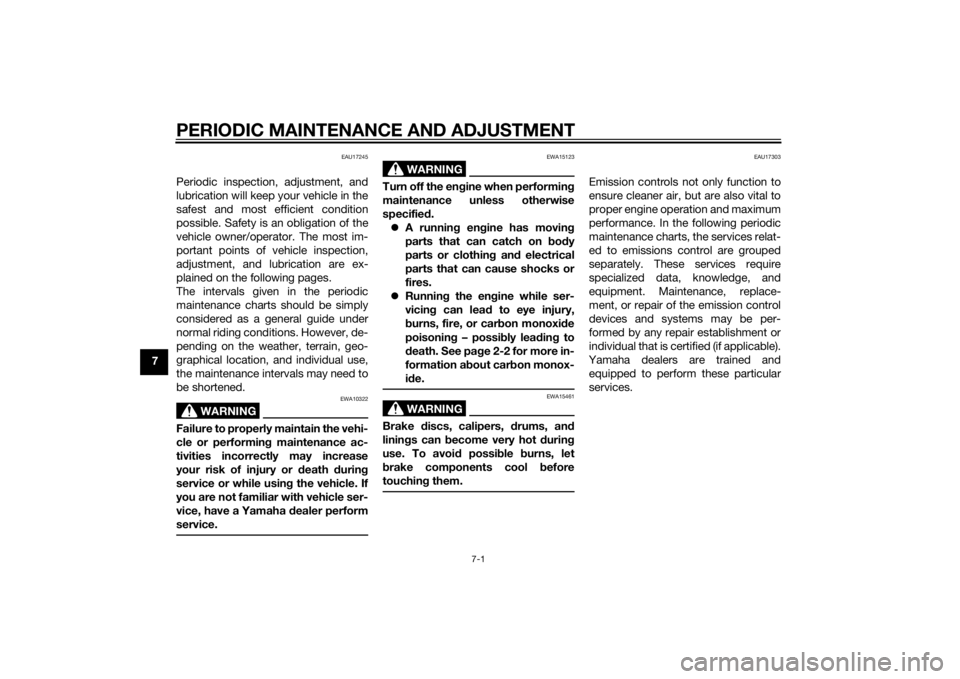
PERIODIC MAINTENANCE AND ADJUSTMENT
7-1
7
EAU17245
Periodic inspection, adjustment, and
lubrication will keep your vehicle in the
safest and most efficient condition
possible. Safety is an obligation of the
vehicle owner/operator. The most im-
portant points of vehicle inspection,
adjustment, and lubrication are ex-
plained on the following pages.
The intervals given in the periodic
maintenance charts should be simply
considered as a general guide under
normal riding conditions. However, de-
pending on the weather, terrain, geo-
graphical location, and individual use,
the maintenance intervals may need to
be shortened.
WARNING
EWA10322
Failure to properly maintain the vehi-
cle or performing maintenance ac-
tivities incorrectly may increase
your risk of injury or death durin g
service or while usin g the vehicle. If
you are not familiar with vehicle ser-
vice, have a Yamaha d ealer perform
service.
WARNING
EWA15123
Turn off the en gine when performin g
maintenance unless otherwise
specified .
A runnin g en gine has movin g
parts that can catch on body
parts or clothin g an d electrical
parts that can cause shocks or
fires.
Runnin g the en gine while ser-
vicin g can lead to eye injury,
b urns, fire, or car bon monoxi de
poisonin g – possi bly lea din g to
d eath. See pag e 2-2 for more in-
formation a bout car bon monox-
i d e.
WARNING
EWA15461
Brake discs, calipers, drums, and
linin gs can b ecome very hot d uring
use. To avoi d possi ble burns, let
b rake components cool before
touchin g them.
EAU17303
Emission controls not only function to
ensure cleaner air, but are also vital to
proper engine operation and maximum
performance. In the following periodic
maintenance charts, the services relat-
ed to emissions control are grouped
separately. These services require
specialized data, knowledge, and
equipment. Maintenance, replace-
ment, or repair of the emission control
devices and systems may be per-
formed by any repair establishment or
individual that is certified (if applicable).
Yamaha dealers are trained and equipped to perform these particular
services.
U2CJ82E0.book Page 1 Monday, June 23, 2014 2:58 PM
Page 45 of 86

PERIODIC MAINTENANCE AND ADJUSTMENT
7-2
7
EAU39945
Periodic maintenance chart for the emission control systemTIP From 7000 km (4200 mi) or 18 months, repeat the maintenance intervals starting from 3000 km (1800 mi) or 6 months.
Items marked with an asterisk should be performed by a Yamaha dealer as they require special tools, data and tech-
nical skills.No. ITEM CHECKS AND MAINTENANCE JOBS INITIAL ODOMETER READINGS
1000 km
(600 mi) or
1 month or 30 hours 3000 km
(1800 mi) or
6 months or 90 hours 5000 km
(3000 mi) or
12 months or 150 hours
1 *Fuel line • Check fuel hoses for cracks or damage.
• Replace if necessary. √√
2 Spark plu g • Check condition.
• Adjust gap and clean.
√√
3 *Valve clearance • Check and adjust valve clearance when engine is cold. √
4 Air filter element • Clean with solvent.
• Replace if necessary. √√
5 *Crankcase
breather sys-
tem • Check ventilation hose for cracks or damage and drain
any deposits.
• Replace if necessary. √√√
6 *Car buretor • Check engine idling speed and starter operation.
• Adjust if necessary.
√√√
7 Exhaust system • Check for leakage.
• Tighten if necessary.
• Replace gasket(s) if necessary. √√
8 *Spark arrester • Clean. √
9En gine oil • Change (warm engine before draining). √√√
U2CJ82E0.book Page 2 Monday, June 23, 2014 2:58 PM
Page 46 of 86

PERIODIC MAINTENANCE AND ADJUSTMENT
7-3
7
EAU3534D
General maintenance and lu brication chartTIP From 7000 km (4200 mi) or 18 months, repeat the maintenance intervals starting from 3000 km (1800 mi) or 6 months.
Items marked with an asterisk should be performed by a Yamaha dealer as they require special tools, data and tech-
nical skills.No. ITEM CHECKS AND MAINTENANCE JOBS INITIAL ODOMETER READINGS
1000 km
(600 mi) or
1 month or 30 hours 3000 km
(1800 mi) or
6 months or 90 hours 5000 km
(3000 mi) or
12 months or 150 hours
1 *Clutch • Check operation.
• Adjust if necessary. √√√
2 *Front brake • Check operation.
• Adjust brake lever free play and replace brake shoes if
necessary. √√√
3 *Rear brake • Check operation.
• Adjust brake pedal free play and replace brake shoes if
necessary. √√√
4 *Wheels • Check runout, spoke tightness and for damage.
• Tighten spokes if necessary. √√√
5 *Tires • Check tread depth and for damage.
• Replace if necessary.
• Check air pressure.
• Correct if necessary.
√√
6 *Wheel bearin gs • Check bearings for smooth operation.
• Replace if necessary.
√√
7 *Swin garm pivot bearin gs • Check bearing assemblies for looseness.
• Moderately repack with lithium-soap-based grease. √√
U2CJ82E0.book Page 3 Monday, June 23, 2014 2:58 PM
Page 47 of 86

PERIODIC MAINTENANCE AND ADJUSTMENT
7-4
7
8Drive chain• Check chain slack/alignment and condition.
• Adjust and lubricate chain wi
th Yamaha chain lubricant
or other suitable chain lubricant thoroughly. Every ride
9 *Steerin g b earin gs • Check bearing assemblies for looseness.
• Moderately repack with lithium-soap-based grease.
√√
10 *Chassis fasteners • Check all chassis fitting and fasteners.
• Correct if necessary. √√√
11 Brake lever pivot shaft • Apply lithium-soap-based grease lightly. √√
12 Brake pe dal pivot shaft • Apply lithium-soap-based grease lightly. √√
13 Si destan d pivot • Check operation.
• Apply lithium-soap-based grease lightly. √√
14 *Front fork • Check operation and for grease leakage.
• Replace if necessary. √√
15 *Shock a
bsor ber assem-
b ly • Check operation and for oil leakage.
• Replace if necessary.
√
16 *Control ca bles • Apply Yamaha cable lubricant or other suitable cable lu-
bricant thoroughly. √√√
17 *Throttle grip • Check operation.
• Check throttle grip free play, and adjust if necessary.
• Lubricate cable and grip housing. √√√
No. ITEM CHECKS AND MAINTENANCE JOBS
INITIAL ODOMETER READINGS
1000 km
(600 mi) or
1 month or 30 hours 3000 km
(1800 mi) or
6 months or 90 hours 5000 km
(3000 mi) or
12 months or 150 hours
U2CJ82E0.book Page 4 Monday, June 23, 2014 2:58 PM
Page 48 of 86
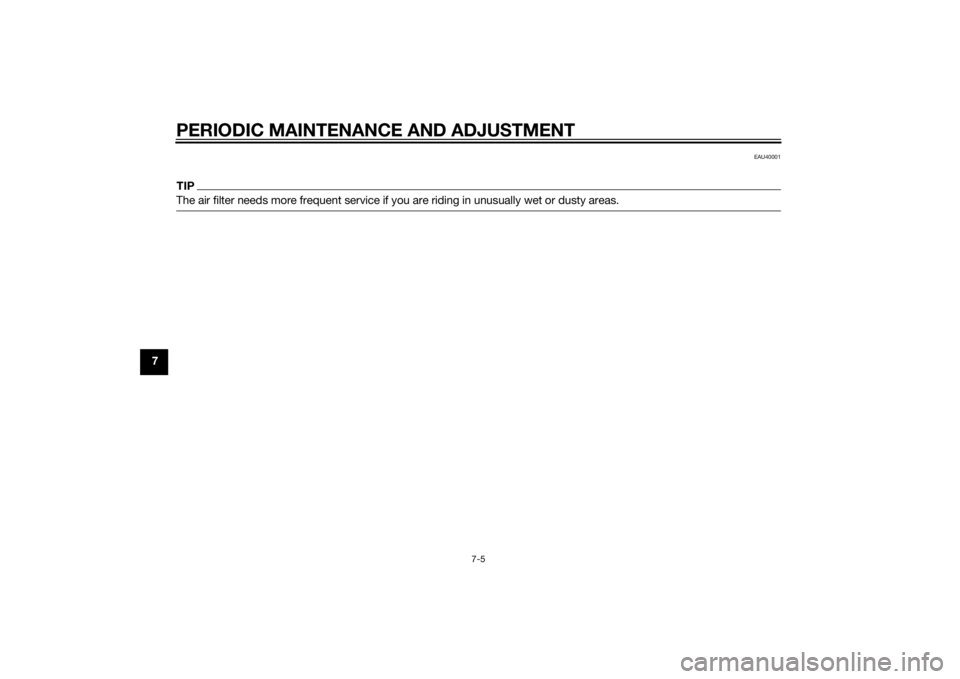
PERIODIC MAINTENANCE AND ADJUSTMENT
7-5
7
EAU40001
TIPThe air filter needs more frequent service if you are riding in unusually wet or dusty areas.U2CJ82E0.book Page 5 Monday, June 23, 2014 2:58 PM
Page 49 of 86
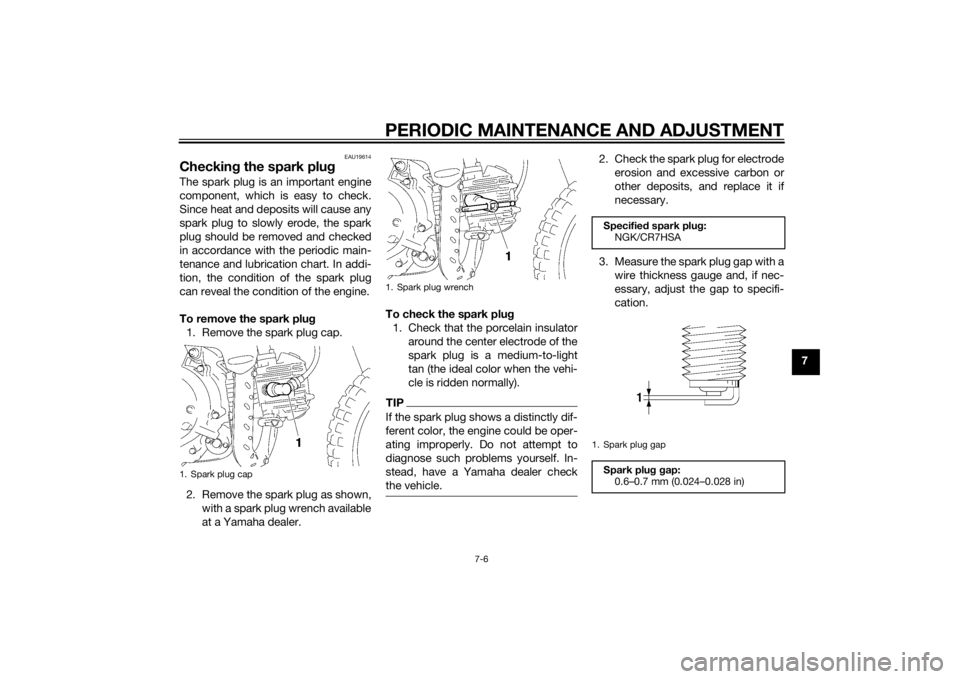
PERIODIC MAINTENANCE AND ADJUSTMENT
7-6
7
EAU19614
Checking the spark plugThe spark plug is an important engine
component, which is easy to check.
Since heat and deposits will cause any
spark plug to slowly erode, the spark
plug should be removed and checked
in accordance with the periodic main-
tenance and lubrication chart. In addi-
tion, the condition of the spark plug
can reveal the condition of the engine.
To remove the spark plu g
1. Remove the spark plug cap.
2. Remove the spark plug as shown, with a spark plug wrench available
at a Yamaha dealer. To check the spark plu
g
1. Check that the porcelain insulator around the center electrode of the
spark plug is a medium-to-light
tan (the ideal color when the vehi-
cle is ridden normally).
TIPIf the spark plug shows a distinctly dif-
ferent color, the engine could be oper-
ating improperly. Do not attempt to
diagnose such problems yourself. In-
stead, have a Yamaha dealer check
the vehicle.
2. Check the spark plug for electrodeerosion and excessive carbon or
other deposits, and replace it if
necessary.
3. Measure the spark plug gap with a wire thickness gauge and, if nec-
essary, adjust the gap to specifi-
cation.
1. Spark plug cap
1. Spark plug wrench
Specified spark plu g:
NGK/CR7HSA
1. Spark plug gap
Spark plu g g ap:
0.6–0.7 mm (0.024–0.028 in)
U2CJ82E0.book Page 6 Monday, June 23, 2014 2:58 PM
Page 50 of 86
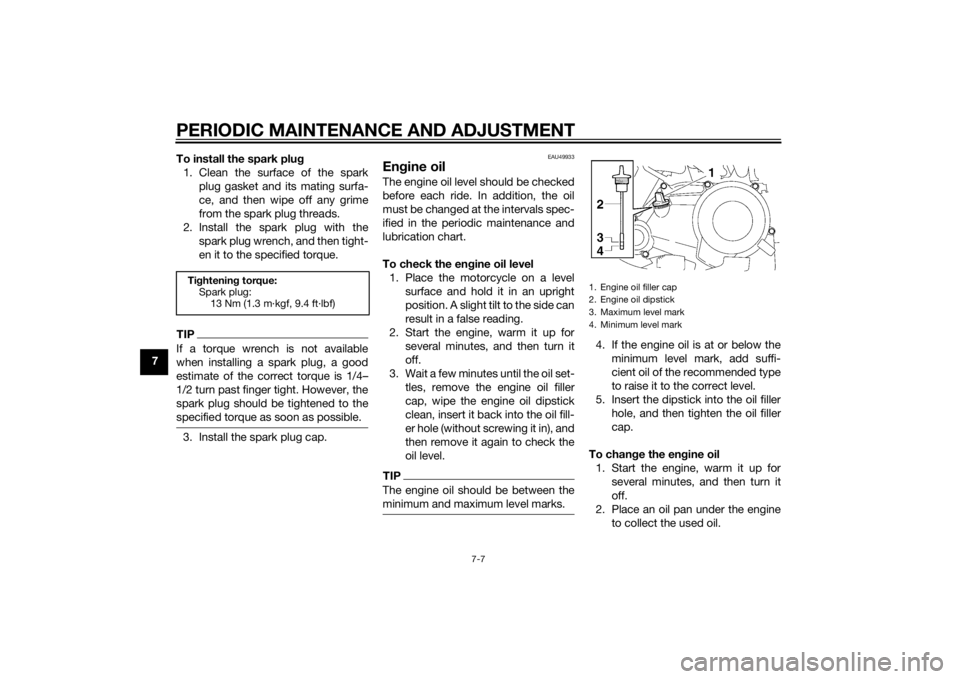
PERIODIC MAINTENANCE AND ADJUSTMENT
7-7
7To install the spark plu
g
1. Clean the surface of the spark plug gasket and its mating surfa-
ce, and then wipe off any grime
from the spark plug threads.
2. Install the spark plug with the spark plug wrench, and then tight-
en it to the specified torque.
TIPIf a torque wrench is not available
when installing a spark plug, a good
estimate of the correct torque is 1/4–
1/2 turn past finger tight. However, the
spark plug should be tightened to the
specified torque as soon as possible.3. Install the spark plug cap.
EAU49933
Engine oilThe engine oil level should be checked
before each ride. In addition, the oil
must be changed at the intervals spec-
ified in the periodic maintenance and
lubrication chart.
To check the en gine oil level
1. Place the motorcycle on a level surface and hold it in an upright
position. A slight tilt to the side can
result in a false reading.
2. Start the engine, warm it up for several minutes, and then turn it
off.
3. Wait a few minutes until the oil set- tles, remove the engine oil filler
cap, wipe the engine oil dipstick
clean, insert it back into the oil fill-
er hole (without screwing it in), and
then remove it again to check the
oil level.TIPThe engine oil should be between the
minimum and maximum level marks.
4. If the engine oil is at or below theminimum level mark, add suffi-
cient oil of the recommended type
to raise it to the correct level.
5. Insert the dipstick into the oil filler hole, and then tighten the oil filler
cap.
To chan ge the en gine oil
1. Start the engine, warm it up for several minutes, and then turn it
off.
2. Place an oil pan under the engine to collect the used oil.
Tightenin g torque:
Spark plug: 13 Nm (1.3 m·kgf, 9.4 ft·lbf)
1. Engine oil filler cap
2. Engine oil dipstick
3. Maximum level mark
4. Minimum level mark
U2CJ82E0.book Page 7 Monday, June 23, 2014 2:58 PM